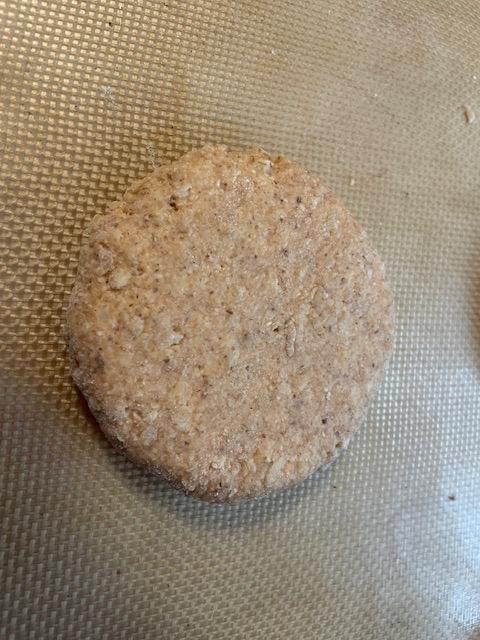-
Posts
1,785 -
Joined
-
Last visited
Contact Methods
-
Website URL
http://debunix.net
Profile Information
-
Location
Los Angeles, CA
Recent Profile Visitors
5,764 profile views
-
Not sure what happened to display the font in reverse color, so weird and I can't edit that. Curried Carrot-Parsnip Soup Invented on a chilly night's ride home from work....and this one came out so nice that I had to share. The parsnips complement the carrots wonderfully, being sweet and mild when cooked, and while you could get something nice with carrots alone, it would not be as good. 1 t mustard oil or other vegetable oil 1 tsp cumin 1 medium onion, coarsely chopped 4 medium carrots, sliced thickly 3 medium parsnips, sliced thickly 4 dried tamarind pods, shelled 6 pods cardamom 1 tbsp whole coriander seed 1 tsp dried galangal chunks 3 C water 1/4 C unsweetened coconut 2 tsp freshly grated ginger 2 tsp cayenne, or to taste 1 tsp paprika, or to taste 1 tbsp south indian sambar powder (from 1000 Indian Recipes by Neelam Batra) or another curry powder of your choice 1 tsp salt or to taste In a pressure cooker, heat the oil and cumin briefly, then saute the onion lightly. Add the carrots and parsnips, water, and, in a small metal bowl set on top of the vegetables, the tamarind, cardamom, coriander and galangal with a bit more water to cover them. Bring up to 15# pressure and cook 12 minutes. While the vegetables are cooking, in another pan, lightly toast the coconut until golden. Strain the separate spice water into the vegetable mixture, pressing the tamarind pulp into the mixture. Puree all in a blender or food processor. Stir in the coconut, ginger, cayenne, paprika, curry powder, and salt, and adjust spices to taste.
-
This is my current favorite, the only version I've liked enough to share on my website (here if you prefer to link to it): Curried Carrot-Parsnip Soup Invented on a chilly night's ride home from work....and this one came out so nice that I had to share. The parsnips complement the carrots wonderfully, being sweet and mild when cooked, and while you could get something nice with carrots alone, it would not be as good. 1 t mustard oil or other vegetable oil 1 tsp cumin 1 medium onion, coarsely chopped 4 medium carrots, sliced thickly 3 medium parsnips, sliced thickly 4 dried tamarind pods, shelled 6 pods cardamom 1 tbsp whole coriander seed 1 tsp dried galangal chunks 3 C water 1/4 C unsweetened coconut 2 tsp freshly grated ginger 2 tsp cayenne, or to taste 1 tsp paprika, or to taste 1 tbsp south indian sambar powder (from 1000 Indian Recipes by Neelam Batra) or another curry powder of your choice 1 tsp salt or to taste In a pressure cooker, heat the oil and cumin briefly, then saute the onion lightly. Add the carrots and parsnips, water, and, in a small metal bowl set on top of the vegetables, the tamarind, cardamom, coriander and galangal with a bit more water to cover them. Bring up to 15# pressure and cook 12 minutes. While the vegetables are cooking, in another pan, lightly toast the coconut until golden. Strain the separate spice water into the vegetable mixture, pressing the tamarind pulp into the mixture. Puree all in a blender or food processor. Stir in the coconut, ginger, cayenne, paprika, curry powder, and salt, and adjust spices to taste.
-
Right back at you, that is lovely bread. I'm really enjoying my not-so-flat loaves that come out of my little pots, and hope that I can get a little more loft with better scoring. It's never going to be as holey--or hold quite as much melted butter--as your loaf, but maybe a little more if I get this bit right.
-
I made these for the birthday of a colleague who cannot eat gluten (taking lots of precautions including cleaning everything before use because everything in my kitchen is covered with flour dust from milling all the time, and using the mill I keep gluten-free for the milling) and loves banana bread. I dislike most banana bread because it is too heavy, too sweet, and bland. These cupcakes are light, buttery, not too sweet for me, and spicy enough to be interesting. And the Date-Coconut-Caramel sauce (not my invention, see below) was the brilliant finishing touch. Banana Cupcakes with Date-Coconut Caramel Sauce Mill together 200 grams sorghum 50 grams sweet brown rice 6 allspice About 3 pieces mace 6 Long peppers 1/2 teaspoon whole mahleb (Substitute about 1/2 teaspoon ground allspice, 1/2 teaspoon ground mace or freshly ground nutmeg, scant 1/2 teaspoon fresh ground long pepper or fresh ground black pepper plus a pinch of ground cardamom, and 1/2 teaspoon ground mahleb seeds or 1 teaspoon almond extract) Remove a portion of the fresh ground flour to food processor and add 185 grams Blue Stripes Banana cacao dried fruit 'gummies'** (packages are 125 grams but I had one and a half on hand) Blitz in food processor until the dried fruit bits are very fine pieces (sesame-seed like) so they can hydrate and soften by the end of baking. 50 grams toasted coconut milk powder* 45 grams flax seed, ground very fine 2/3 cup sugar 2 1/2 tsp baking powder 1/2 tsp baking soda 1/2 tsp salt 100 grams roasted unsalted cashews, grated/ground to a light sandy texture (I use my rotary nut grater for this) Sift/whisk in until all evenly blended 3/4 cup unsalted butter, softened Beat into flour until thoroughly mixed 1 1/2 C thoroughly mashed ripe bananas (premixed with one of the eggs and left to sit for 30 minutes if not fully ripe) Beat until smooth 3 eggs (remember to the one you used to speed-ripen the bananas, if you did that) Beat in one by one and then beat in enough water to make a thick but spoonable batter. Spoon into muffin cups (they can be basically full, they rose to a nice dome but did not overtop the cups) and bake 375°F degrees about 20 minutes (internal temp about 205 degrees). While they cool, prepare date-coconut-caramel as a dip for the topping. I tweaked the original Date Caramel recipe from bakedbymelissa.com a little bit by using powdered coconut milk, some toasted* and some not. I used all 16 large and plump medjool dates in the package I bought, reserved the soaking liquid, zapped in the food processor with some of their soaking liquid, added a scoop of the toasted coconut milk powder, and another 2 scoops of the untoasted coconut milk powder, and then I think all of the rest of the soaking liquid plus some extra water to make a puree just thick enough to dip and coat the top of the cupcakes without dripping down the sides. Next time I will cut this down because this made twice as much as I needed for 2 dozen cupcakes. *I always keep coconut milk powder on hand and not coconut milk, and I toast some of it from time to time in the oven or in a skillet for extra flavor oomph. **I would probably substitute dried unsweetened Philippine mango if I did not happen to have this on hand; as I made it, the banana flavor was heightened by the dried banana and the dried cacao fruit is quite tart and not very chocolatey.
-
I actually tried one of those Lodge pots with the flat frying pan lids, but my loaves came out too flat. So I'm using some 1.5 qt pots I found on Amazon after lots of searching. They're just a bit over 5 inches in diameter, so the space for scoring is quite confined. (I posted a bit about the loaves with some photos in the Ancient & heritage grains topic here).
-
I'm pretty happy with my current daily bread, enough that I'm trying to figure out all the little hacks and tweaks to make it as perfect as possible. I bought 50# of Kernza after trying some fabulous prepackaged smaller quantities, and while the bulk version did not have the same marvelous floral notes as that one smaller batch did, it has a wonderful nutty flavor and these loaves end up just a wee bit sour, nutty and sweet. I add a fair bit of flax for more omega 3 and to help with low gluten from Kernza grain. The loaves are quite small, because I'm primarily baking for one and since I officially crossed over to diabetes, I can only eat so much bread, even when it is as fiber-filled as I can make it. Mill together to fairly fine wheat 185 grams Joaquin oro hard red wheat 100 grams Kernza Add to food processor along with 180 mL water And pulse several times to wet the flour but not necessarily a smooth dough. Separately, stir together and let thicken 18 grams flax, freshly ground 30 mL water After 30 minutes of autolyse, add these to the food processor 1 teaspoon salt A scant 1/8 teaspoon dimalt:ascorbic acid:all purpose flour mix [1.3 g ascorbic acid with 6.5 g dimalt mix plus 7.8 g all purpose flour to dilute it enough to measure it out] The flax gel prepared above 60 grams refreshed starter And briefly process, adding extra water as needed for a soft smooth dough (about 40-50 mL). Knead just a bit by hand to be sure any harder lumps are worked in. Place in a bowl, transfer to proof box set at 90 degrees and let rise a couple of hours. Turn out, knead/fold a couple of times and set to refrigerator overnight. Return to proof box, let rise, gently knead/shape with just 2-3 more turns, then proof open in flour/fabric lined 'banneton' [improvised from a deep fryer basket and bit of old sheet to fit my mini dutch oven (1.5L)] while preheating the pot & oven to 475° (at least 30 minutes, longer if the dough needs it). Flip out *gently* onto strip of floured parchment. Use this sling to place the loaf in the heated dutch oven. Cover and bake 475°F x 15 minutes. Remove lid & drop temp to 425°F for 10 minutes. Pop it out of the pot and place directly on oven rack. Drop temp to 350°F and bake another 15 minutes. Bake to 210°F internal temperature. [url=https://flic.kr/p/2rti61i][img]https://live.staticflickr.com/65535/54786490877_6af32b1b12_z.jpg[/img][/url][url=https://flic.kr/p/2rti61i]Oven SPRING![/url] by [url=https://www.flickr.com/photos/debunix/]debunix[/url], on Flickr I created a photo essay on my Flickr for an earlier version of this bread with a different flour mix (hard white wheat without the kernza), but the results are very similar with the kernza/Joaquin oro,nice rise and crust but slightly gummy crumb. These loaves are so nice now that I’m working to really try to perfect the recipe: the bread comes out with just a hint of sourness plus really nice nutty whole wheat flavor. I've already played with saltolyse vs autolyse, different time/temp steps for the baking, and using or skipping my home-made bread improver. And because my low-gluten loaves came out so flat if the sides weren't supported, I searched and searched and found some fabulous 1.5 quart dutch ovens that are just right for one of my loaves (my previous generic loaf starting with 500g wheat was too much for these little pots). *I’m using my own starter that I began with the Pineapple Juice Solution from Breadtopia & Peter Reinhart, but starting with, and consistently refreshed with a fresh milled emmer:barley 50:50 blend flour. It’s a remarkable starter, the best I’ve ever had. After refreshing to make a loaf, I cover it with a thick layer of the emmer:barley flour, and I just leave it in the refrigerator in a glass wire-bail jar, sealed. I open it up the night before I want to use it, stir the covering flour and some fresh filtered water into it, and keep it room temp overnight, or in a proof box if I want to use it a little sooner. I suspect the barley is a big part of why it is such a very happy riser.
-
Pardon if I am repeating a discussion mentioned above (this is quite a long topic)....but I am struggling with how to make my slashes when using a preheated dutch oven to bake my loaves. My low-gluten dough is quite soft and I am worried that if turn it out of its banneton and slash while it is on the parchment paper sling the extra time will permit it to flatten too much to fit into the pan. Once it is in the pan, the top to be slashed is well below the rim of the extremely hot dutch oven. Most lames seem made to draw horizontally across the surface of the loaf--and my fingers cringe at the possibility of burning my fingers if I use that style. What solutions do you use with dutch-oven baked loaves?
-
Chia and flax and timing of butter addition I just made a batch of cookies using non-wheat flour and ground nuts, with about 10% ground chia to help the eggs to hold them all together, and decided mostly on a whim to beat the softened butter into the flours, and then add the wet ingredients (honey/molasses mix and eggs). I then set it up as icebox cookies (e.g., slicing chilled rolls of dough for baking). I noticed that the dough had poor cohesion and was very hard to slice without it falling apart, and when I touched a hot just-baked cookie after the first step and before the drying, it just fell apart (I know all cookies are delicate at that stage, but this was exceptionally so). While there were other possible issues with the slicing--e.g., slicing from the refrigerator rather than straight out of the freezer, and the difficulty of slicing through the larger pieces of the cacao fruit which is very sticky/gummy/dense, I'm wondering whether the timing of the ingredient ordering impacted the ability of the chia to form a gel properly--should I consider whisking it into the eggs or even a bit of water and letting it gel first? Or perhaps was it just not enough chia? I've been playing a lot with different flour mixes to keep variety in my diet, using lots of ground nuts for flavor density as well as to make my cookies a little less carby and have less impact on my blood sugar, and this dough was especially hard to work with. The baked cookies seem medium fragile but not as much as a traditional shortbread cookie. Could the relative richness of the pecans vs almonds (that I've more often used in cookies like this) have been a factor? Mill together: 150g teff 100g sorghum 50g black rice rice 1 teaspoon mahleb 1/2 teaspoon cardamom seeds About 1 teaspoon whole mace 5 Long peppers, chopped Scoop about 1/2 cup of the milled flour together in the food processor with 4 oz (113g) dried cacao fruit, chopped a little bit 2 oz (~55 grams) candied ginger The process until the ginger and cacao fruit are in tiny distinct bits, it will take a while because the cacao is ultra sticky Then add to mixing bowl and strain/sift in: The remaining flour 300 grams (~10 oz) ground pecans 50 grams ground chia 50 grams toasted coconut powder (used 30 grams toasted coconut + 20 grams toasted buttermilk due to not enough coconut) 1 teaspoon powdered ginger 2 teaspoons ammonium bicarbonate or 1 1/2 teaspoons baking powder 1 teaspoon salt [had planned to add 75 grams (~3 oz) Cacao nibs (forgot these this time)] Beat in 1 cup (225g) unsalted butter, softened but not melted until well mixed. Mix in: 1/3 cup Popcorn sauce (substitute 1/4 cup molasses plus 2 tablespoons honey, I keep a 2:1 mix of these on hand for popcorn that has a Cracker Jack like flavor) 2 Eggs Form into rolls, chill until firm. Preheat the oven to 350 before slicing 1/8 inch thick and placing onto silpat lined baking sheets. Baked about 10 minutes. Let oven cool down to 200 degrees and flipped over, returned to oven for another 30 minutes, then left in over as it cooled down overnight to dry completely [to evaporate any funky ammonia leftovers and maximize crunch].
-
I should call these inspired by Kulluoba bread, rather than a real attempt at recreation given the multiple liberties I took with the process and lack of access to detailed reports to suggest a proportion of defining ingredients in the original as per the link above: Kulluoba bread 250531 100 grams bulgur soaked in 100 grams boiling water, cooled About 1/2 cup Sourdough starter (started and maintained with 50-50 fresh milk barley/emmer flours, refreshed the night before and quite vigorous) (about 130 grams) Coarsely milled together 300 grams emmer wheat 100 grams Lentils (red/shelled) 25 grams flaxseed, ground separately (added to get a little more omega-3 in my diet, not authentic) 1 teaspoon salt Started with one cup of water but had to add quite a bit more and did not accurately measure it through the process. Once the bulgar had cooled to lukewarm, I used my entirely anachronistic food processor to zap the starter, bulgar, flours, flax, salt together and then poured in the water and zapped a bit more. It rose quite slowly at first, so I punched it down and left it to go overnight after it barely increased to maybe 30% more than initial volume. The next morning it had risen to almost double in bulk when I punched it down, shaped it into little discs about 3 inches in diameter and half an inch thick. I covered them with a damp towel and let them rise for about an hour and a half. they were baked at 375 in the convection oven for about 35 minutes and that might've been a little long because a couple of them had mildly dark bottoms. The end result were quite sour but tasty little loaves with a very chewy texture courtesy of the bulgar, utterly delicious with honey butter.
-
Cool article about ancient bread: <https://www.rte.ie/news/newslens/2025/0527/1515125-ancient-bread-turkey/> "In the early Bronze Age, a piece of bread was buried beneath the threshold of a newly built house in what is today central Turkey. Now, more than 5,000 years later, archaeologists have unearthed it, and helped a local bakery to recreate the recipe - with customers lining up to buy it. .... Analyses showed that the bread was made with coarsely ground emmer flour, an ancient variety of wheat, and lentil seeds, with the leaf of an as yet undetermined plant used as yeast. .... To get as close as possible to the original recipe, the municipality, after analysing the ancient bread, decided to use Kavilca wheat, a variety that is close to ancient emmer, as well as bulgur and lentils." I've got emmer, and lentil, and bulgur....and now feeling like I must have been channeling an ancient middle-eastern baker when I recently made some random unyeasted flatbreads with bulger, lentils, and barley! Now I need to eat that up so I can make some room in the freezer for Kulluoba bread, and I've got some maybe appropriate sourdough starter made with emmer and barley that is quite lively and pleasing to work with. Will report back.
-
Thank you, this was exactly what I was looking for!
-
The reshaped bread rose beautifully and came out with a very good crumb. So....this time I got away with reshaping and one more rise. But surely I can't be the only baker who sometimes leaves proofing loaves a little too long and has this dilemma from time to time? I also have another question today. This week's loaf has larger holes in the crumb in the middle of the loaf, just a little too high to be the true center of it. I know I've seen troubleshooting guides that discuss possible causes for such faults--where the holes are disproportionate in some parts of the loaf, or crumb texture is off--but I can't find one to hand at the moment in my bread books and am getting a poor signal-to-noise ratio with open internet search. Does anyone have a pointer to a broadly applicable online guide with lots of examples that is about more than just white-flour sourdough hearth breads?
-
A really simple question....maybe....? If I overproof my sourdough bread a little bit, at what point am I better off just doing one more fold/knead and reshaping and reproofing vs just putting it in the oven ASAP & crossing my fingers? I'm using a *very* lively emmer/barley starter and the loaf itself is freshly milled Rouge de Bordeaux hard red wheat. Usually I've been giving this one rise as dough, then shaping, proofing, and baking with good success. Today's loaf was reshaped and put in the proof box in hopes of one more nice rise.....but this is a sadly common question for me.
-
thanks for the thoughts. i'm not worried about the sugar, because I will use brown sugar that for this particular brand is bone char free--although my particular vegan has not brought that issue up herself. It's a small enough quantity that I don't think the bit of molasses will be a problem. But the substitutes for the dairy milk would all be liquid and I've been using and developing recipes with powdered milk to get the flavor with less impact on the texture. I have a team match on the way of soy milk powder available although there's gotta be some that someone has made somewhere.
-
I have a niece who is vegan and want to bake some cookies for her. I've got a fair bit of experience adapting and adjusting recipes for my whole grain baking, and recently have done a lot with gluten-free grains for the sake of friends who are celiac, and I've been adjusting recipes for my own borderline diabetes, but working exclusively with vegan ingredients is new to me. I see a handful of topics here that are mostly a decade or more old, and the choices of ingredients are different today, and there are lots more experienced vegan bakers out there now. So I thought a new topic was appropriate, but I'm happy to take this to another topic if I've overlooked one already in progress. Here is one of my own recipes I thought I might start with: https://debunix.net/recipes/FiveByFiveChocolateCookies.html Lightly greased or lined baking sheets Oven 350°F / 175° C Baking time 12 minutes 3/4 cup / 170 grams unsalted butter (if what you have is salted, see adjustment below) 3/4 cup / 150 grams sugar 3 1/2 ounces / 100 grams unsweetened chocolate 3 large eggs 3 tablespoons / 45 grams water OR 1/4 cup buttermilk OR 1/4 cup water [1 teaspoon vanilla if not using vanilla bean] Milled together 225 grams teff 2 inches vanilla bean [OR use 1 teaspoon vanilla extract, added with the eggs and buttermilk or water] Alternatives for the flour 1 1/2 cups / 225 grams teff flour [OR 1 1/2 cup / 225 grams whole wheat pastry flour OR soft wheat flour OR unbleached all purpose flour] 2 tablespoons / 12 grams buttermilk powder [omit if using buttermilk] 1/2 cup / 75 grams cocoa 10 grams ground chia seeds [omit if using wheat flour] 1 teaspoon baking powder 1/2 teaspoon salt [omit if using salted butter] 4 ounces / 113 grams dried cacao fruit, minced 1/2 cup / 2 ounces or 60 grams cacao nibs 2 ounces / 56 grams finely chopped bittersweet chocolate (I love 70% Sambirano from Dick Taylor, or Scharffenberger 70%) Melt the butter and unsweetened chocolate together (I do it in the microwave on lower power to avoid scorching the chocolate, stirring often). Transfer to mixer bowl, and beat together with the sugar. Beat in the eggs, water or buttermilk and vanilla if you are using that. Take half of the flour and whirl in food processor with the dried cacao fruit until the fruit is very finely minced. This stuff is STICKY and the food processor struggles a bit to manage it; I have to stop and pick the gummy coating off the blade a few times to get it done. You can also chop it with a knife but it is hard work and the knife will need a lot of clearing too. Sift or whisk the flours, chia [if using gluten-free flours], salt, baking powder, buttermilk powder [if using] together, and add to the mixing bowl together with the the flour/cacao fruit, cacao nibs, and chopped chocolate. Stir together until well mixed. Icebox/Refrigerator cookies version: work less, eat later This is how I made them the second time, and I think it worked better: let sit for several hours at room temperature or in the refrigerator, to hydrate the flour and let the dough firm up enough to be shaped into rolls. Take about 1/3 of the dough and form into a roll, about 2 inches in diameter, and wrap in waxed paper or parchment or plastic wrap, and chill until quite firm for neat slicing (about 2 hours in freezer, overnight in refrigerator). When ready to bake, preheat the oven to 325°F / 163° C. Slice the rolls 1/4 inch thick and place on prepared baking sheets (lightly greased, or lined with parchment or silpat). Bake 325°F for about 12 minutes, until they are a little dry and firm on the outside, should still be a little soft but not gooey inside. Hand-rolled balls version: work harder, eat sooner This is how I originally made them: let sit for several hours at room temperature or in the refrigerator, to hydrate the flours. Preheat the oven to 325°F / 163° C. Roll teaspoonsful of dough into small balls, flatten them a little, place them fairly close together on lightly greased or parchment or silpat lined baking sheets (they won't spread much). Bake 325°F for about 12 minutes, until they are a little dry and firm on the outside, should still be a little soft but not gooey inside. *********** For these cookies, I've obtained some food-grade cocoa butter, and I was thinking of cutting that with some canola or Algae oil to keep it from being too hard--since cocoa butter is harder than butter at relevant room temperature, and might make things harder for cutting the chilled logs of dough. But I'm a bit at sea trying to guess how much of the oils to mix with the cocoa butter; and I know I need to get the cocoa butter or mixed butter/oil soft enough for creaming with the sugar, and if I were to mix these together I'd need to melt the cocoa butter, let it solidify, and then use it when room temperature-ish and not too hard. And I've already used chia to help with the lack of gluten in teff, but I figure I need more of that +/- flax to help with the egg. I figure flake yeast can add some umami that would help with the lack of buttermilk powder and maybe also the missing milk solids in the butter....but not sure what else to add that dairy richness. Open to suggestions!



















